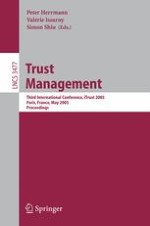This volume constitutes the proceedings of the 3rd International Conference on Trust Management, held in Paris, France, during 23–26 May 2005. The conf- ence follows successful International Conferences in Crete in 2003 and Oxford in 2004. All conferences were organized by iTrust, which is a working group funded as a thematic network by the Future and Emerging Technologies (FET) unit of the Information Society Technologies (IST) program of the European Union. The purpose of the iTrust working group is to provide a forum for cro- disciplinary investigation of the applications of trust as a means of increasing security, building con?dence and facilitating collaboration in dynamic open s- tems. The notion of trust has been studied independently by di?erent academic disciplines, which has helped us to identify and understand di?erent aspects of trust. Theaimofthisconferencewastoprovideacommonforum,bringingtogether researchers from di?erent academic branches, such as the technology-oriented disciplines, law, social sciences and philosophy, in order to develop a deeper and more fundamental understanding of the issues and challenges in the area of trust management in dynamic open systems. The response to this conference was excellent; from the 71 papers submitted to the conference, we selected 21 full papers and 4 short papers for presentation. The program also included two keynote addresses, given by Steve Marsh from National Research Centre Canada, Institute for Information Technology, and Steve Kimbrough from the University of Pennsylvania; an industrial panel; 7 technology demonstrations; and a full day of tutorials.
